Iranian accounts promote anti-Israel hashtags in the wake of the Israel-Hamas war
The campaign, promoted on Telegram, is linked to an Iranian conspiracy theorist previously suspended from Twitter.

A Palestinian stands on a house that was destroyed in an Israeli air strike during the fighting between Israel and Hamas in May 2021, in the northern Gaza Strip on June 29, 2021. (Source: REUTERS/Mohammed Salem)
In April 2020, a set of Iranian accounts began promoting the anti-Israel hashtag #COVID1948. #COVID1948 connects the founding of the state of Israel to the novel coronavirus, implying that Israel has been far worse for the world than the current COVID-19 pandemic. As initially reported by the Stanford Internet Observatory, after attaining a peak in May 2020, the hashtag largely fell into disuse. However, in the wake of the 11-day 2021 Israel-Hamas war, #COVID1948 was promoted vigorously by a group of Iranian accounts, gained renewed popularity, and trended throughout the world, including the United States.
In the May 2021 wave of the #COVID1948 hashtag, the DFRLAB identified 9,048 self-identified Iranian accounts that utilized the hashtag. Although Twitter is banned in Iran, many Iranians continue to make use of the site using a VPN. These included accounts self-identifying their location as Iran or prominently displaying Iranian flags on their profile and tweeting in Farsi.
The renewed global attention on Israel during the Israeli-Hamas war, caused #Covid1948 to trend on Twitter in the United States. Later in June 2021, many of these same accounts explicitly coordinated to promote and trend another hashtag, #USSLiberty. This hashtag seeks to rehash the Israeli bombing of the USS Liberty during the Six-Day Arab-Israeli War in 1967. Altogether, the DFRLab found that these pro-Iranian accounts coordinated together in May and June to promote animus and anti-Israel sentiment.
The renewed use of the COVID1948 hashtag
The #Covid1948 hashtag was first used on April 19, 2020, by a Palestinian lawyer who argued “#VirusCorona and #isreal [sic] occupation are two faces of the same coin.” After peaking on May 15 of that year, very few accounts continued to use the #COVID1948 hashtag. In the wake of the Sheikh Jarrah land dispute in May 2021, though, several accounts began to revive the hashtag. Sheikh Jarrah is a primarily Palestinian neighborhood in East Jerusalem. Due to disputed land claims, several Palestinian families faced possible eviction from their homes. The resulting conflict finally escalated into violence on May 6, 2021. This violence coincided with the first uptick in the use of the #COVID1948 hashtag. The DFRLab found that at least 163 Iranian accounts used the hashtag with reference to the Sheik Jarrah controversy for a total of 271 tweets.
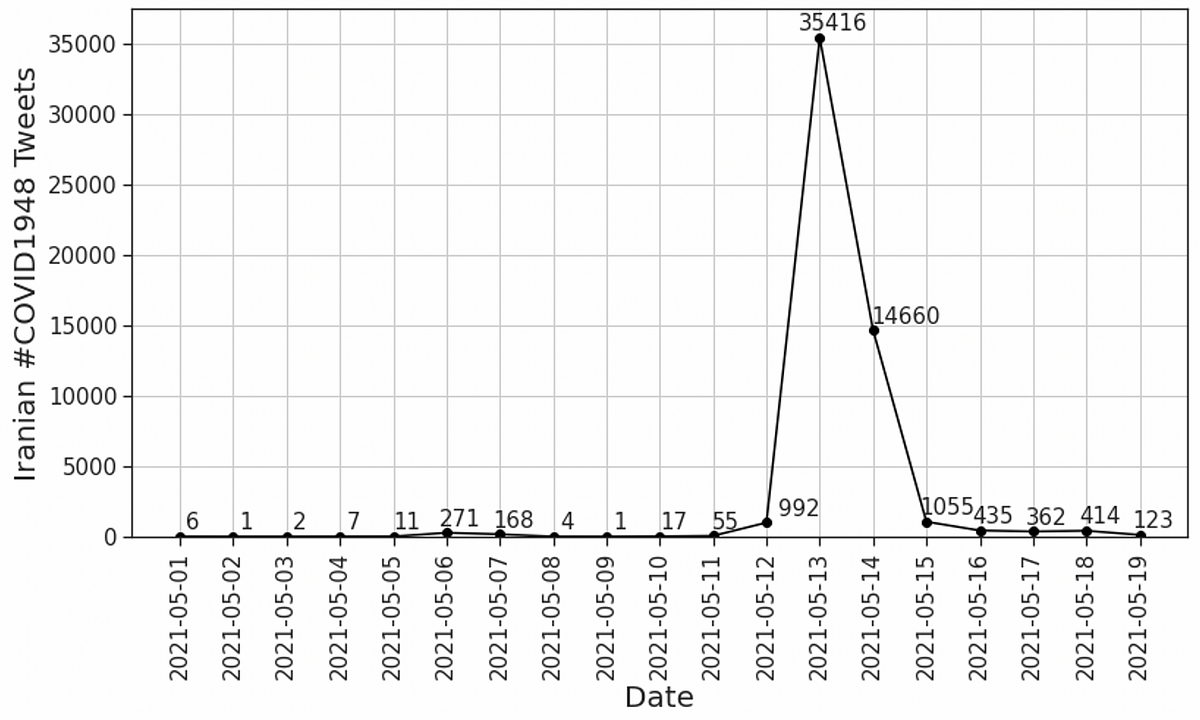
The full resurgence of the #COVID1948 hashtag from these Iranian accounts did not come, however, until the start of the 11-day Israel-Hamas war. From May 12 to May 15, a coordinated effort occurred among Iranian accounts. A total of 280, 2,603, 1,906, and 411 Iranian accounts utilized the #COVID1948 on each day respectively. Altogether, throughout the Israel-Hamas war, #COVID1948 was tweeted by these accounts over 54,000 times.
After the spike in Iranian Twitter users utilizing #COVID1948, the hashtag was able to travel outside of just Iran, with actor Mark Ruffalo retweeting a tweet that contained it. However, the hashtag, despite being used throughout the world, was used mostly by self-reported Iranian users.


One of the most avid tweeters, @amahdi_sh, tweeted the hashtag 310 times on May 13 alone. This account was created on May 5, 2021, in the wake of the Sheikh Jarrah controversy. After tweeting these hashtags, the account has since tweeted heavily pro-Iranian content, including promoting the 2021 Iranian presidential election. Following the election, the account was deleted.
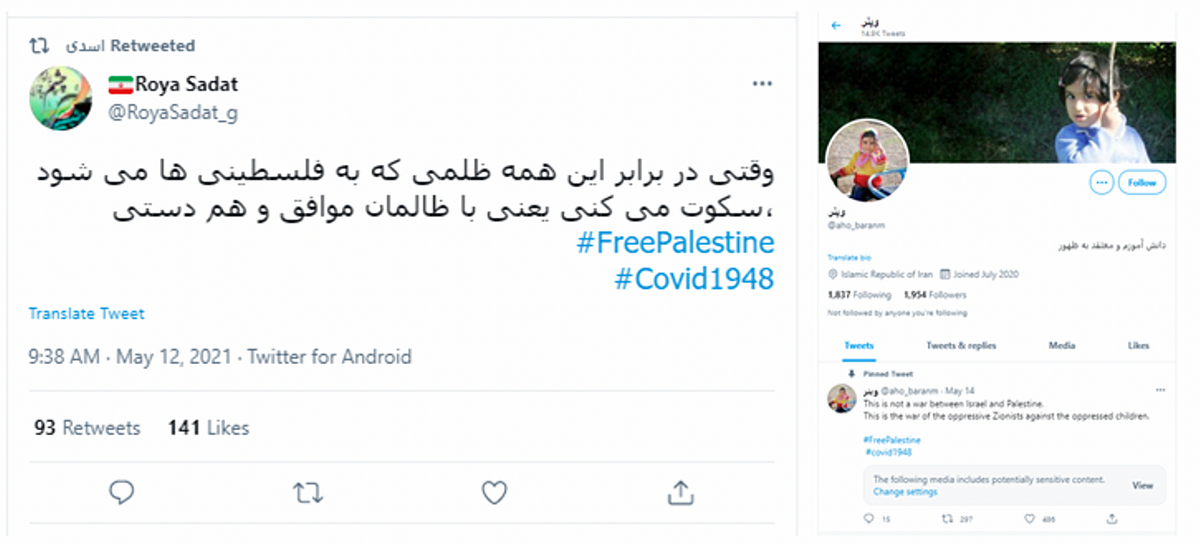

A coordinated campaign
As in the first wave of use, the spike in the #COVID1948 hashtag’s popularity seems to have been coordinated by a key Iranian account. During the initial spike of the #COVID1948 hashtag, the Stanford Internet Observatory found that Aliakbar Raefipour and his Masaf Institute were among some of the most prominent spreaders. During the initial appearance of the hashtag, at least five different accounts under Raefipour’s name were used to spread the hashtag. Raefipour describes himself as a university lecturer and a researcher in “the apocalyptic topics and cults.” At the end of May 2020, however, many of Raefipour’s accounts were suspended.
In December 2020, a new account was created under Raefipour’s name that has largely been able to fly under the radar until now. This account appears to again have helped coordinate the spread of the #COVID1948 hashtag. From a Telegram channel ostensibly run by Raefipour’s Masaf Institute and linked by @A_raefipur’s Twitter account, the DFRLab found a message instigating Iranian Twitter users to again broadcast the #COVID 1948 hashtag during the Israel-Hamas war:
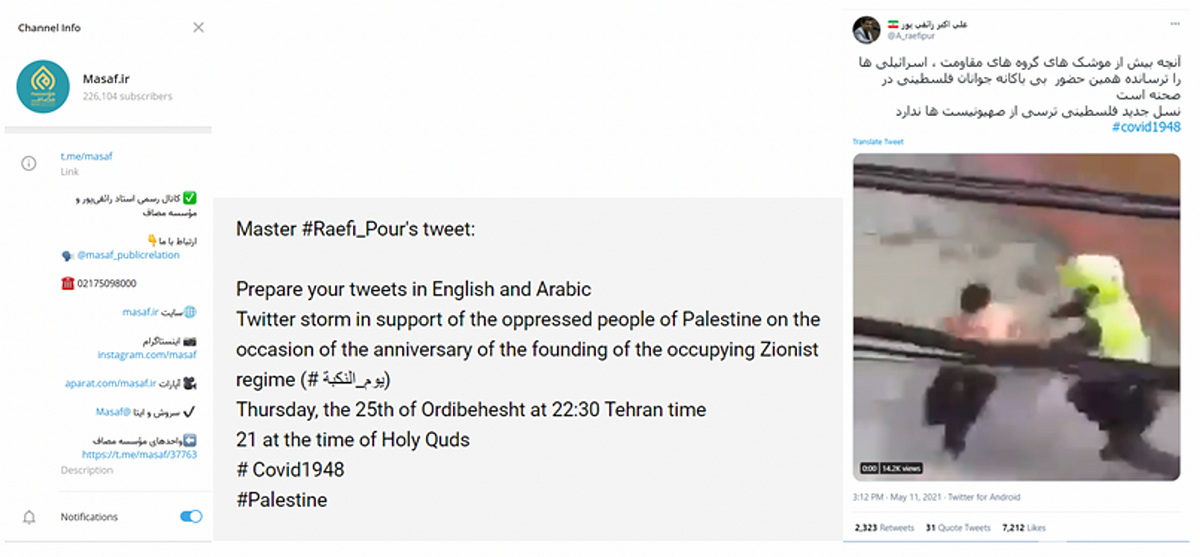
Raefipour’s most popular tweet, responding to a message by former U.S. Vice President Mike Pence, played an instrumental role in helping to spread the #COVID1948 hashtag. Among all of the #COVID1948 tweets from Iranian users, it gained the most engagement.

Raefipour’s tweet, was retweeted over 3,700 times and liked over 8,500 times over the course of the spike in the #COVID1948 hashtag.

In addition to this tweet, Raefipour posted several others containing the hashtag, gaining a collective of 50,307 likes and 18,269 retweets, eclipsing the numbers he received during the first wave of the #COVID1948 hashtag in May 2020 as reported by the Stanford Internet Observatory (35,500 favorites and 13,100 retweets).

Since the ceasefire that ended the Israel-Hamas War on May 20, Raefipour has continued to promote material from his older deleted accounts. In addition, the DFRLab has found that he has begun a new coordinated campaign to stoke anti-Israeli sentiment with the hashtag #USSLiberty.
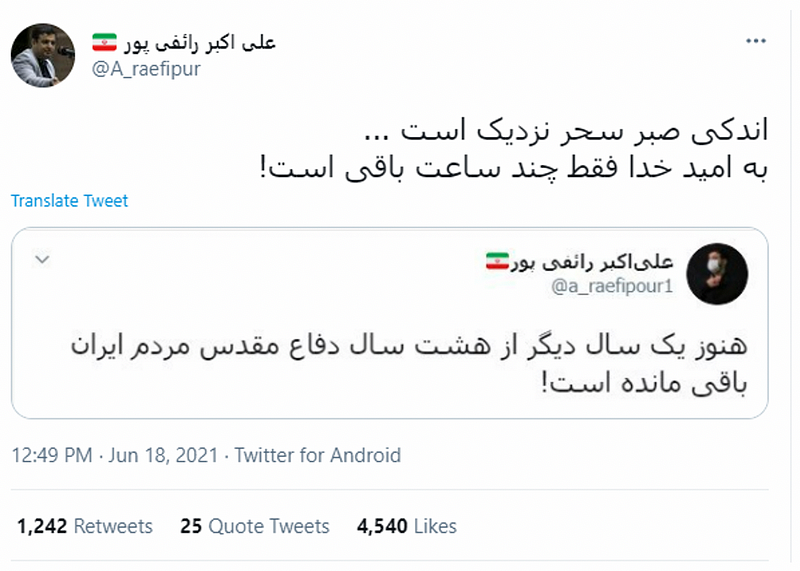
A new campaign: USS Liberty
During the Six-Day Arab-Israeli War on June 8, 1967, an Israeli Air Force jet fighter and Israeli Navy torpedo boat attacked the United States Navy ship USS Liberty, killing 34 and wounding 171. Israeli immediately apologized for the attack, saying that they had mistaken the USS Liberty for an Egyptian ship.
The Masaf Institute’s Telegram channel encouraged its followers to promote the #USSLiberty hashtag, writing that “Zionism’s strong media domination of the world caused this incident to be severely boycotted and a large part of the American people were never informed about it!”
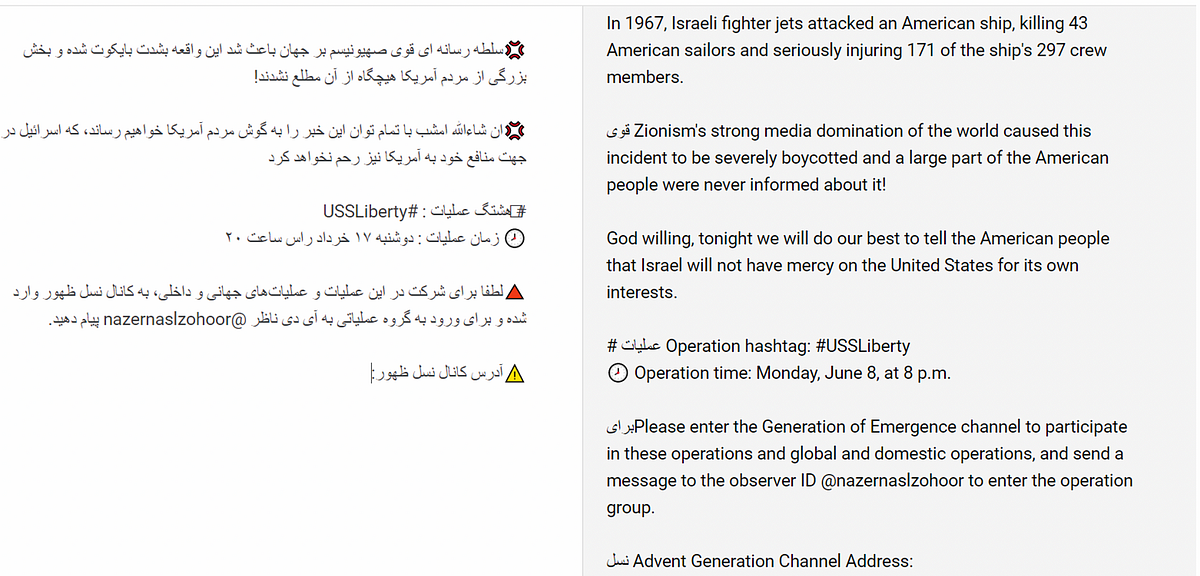
Tweeted over 15,000 different times by Iranian accounts since June 7, 2021, this campaign again seems to have originated with Raefipour. As of June 18, 2021, Raefipour continues to have the most retweeted and favorited messages utilizing this new hashtag.
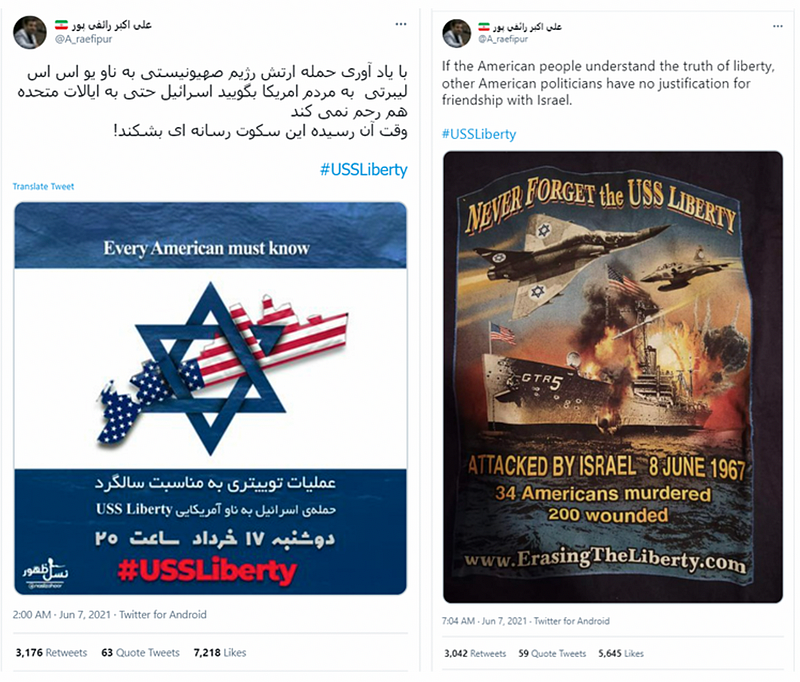
This initial analysis has shown that a coordinated campaign by Iranian accounts appears to have caused the Anti-Israel #COVID1948 and #USSLiberty hashtags to trend in the United States. Aliakbar Raefipour, a conspiracy theorist whose accounts have previously been suspended from Twitter, appears to have an outsized role in promoting this campaign.
Hans Hanley is a research intern with the Digital Forensic Research Lab.
Cite this case study:
Hans Hanley, “Iranian accounts promote anti-Israel hashtags in the wake of the Israel-Hamas war,” Digital Forensic Research Lab (DFRLab), July 1, 2021, https://dfrlab.org/2021/07/01/iranian-accounts-promote-anti-israel-hashtags-in-the-wake-of-the-israel-hamas-war/.

